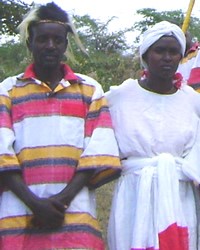Dawro in Ethiopia

Photo Source:
Communication Affairs Department
|
Send Joshua Project a map of this people group.
|
| People Name: | Dawro |
| Country: | Ethiopia |
| 10/40 Window: | Yes |
| Population: | 1,044,000 |
| World Population: | 1,044,000 |
| Primary Language: | Dawro |
| Primary Religion: | Christianity |
| Christian Adherents: | 92.00 % |
| Evangelicals: | 53.23 % |
| Scripture: | Complete Bible |
| Ministry Resources: | Yes |
| Jesus Film: | Yes |
| Audio Recordings: | Yes |
| People Cluster: | Omotic |
| Affinity Bloc: | Horn of Africa Peoples |
| Progress Level: |
|
Introduction / History
Before going to the detail discussion of the topic, it is very important to make some points on the confusion surrounding the names Dawro, Dauro, Dawaro and Dawuro. Except few scholars, most have written in their documents the names Dawro, Dauro and Dawaro for Dawuro. The mistake might have been made due to the scholars' or writers' deficiency in a certain area of language skills, lack of sufficient knowledge of Dawuro culture and history, and/or other causes. In short of these four names, the correct one is Dawro. The name " Dawro " represents both the land and the people. Dawro people belong to Omotic family.
The landscape of Dawro is mostly mountains, plateaus, deep gorges and low land plains.
Thus, Dawuro exhibits climatic variations from lowland to highland. This enriched Dawro with a variety of tree species and natural vegetation/forest. For instance, Churuchura-Chabara National Park, natural forests along Gojeb and Omo rivers valleys and other bigger rivers in the zone. Dawro is also endowed with perennial rivers.
What Are Their Lives Like?
The 2nd biggest hydroelectric power generation dam in Ethiopia now, Gibe III, is being built on Omo river between the Dawro and Wolayita zones. The capital town of Dawro is Tarcha.
Although Dawro has not been well known by most Ethiopian and western scholars until recently, thanks to EPRDF government and Gibe III project, its remarkable history and fascinating culture and their heritages have been well known. Among the heritages, two astonishing ones are the great defensive Walls and the longest woodwind musical instrument in the world locally called "Dinka" (4 to 5 meters long, four in number). Dawro had been a highly centralized powerful independent Kingdom until it was incorporated into Modern Ethiopia by Emperor Menelik in 1893.
What Are Their Beliefs?
The earliest forms of Vietnamese worship were animism and veneration for ancestors. The Vietnamese worshiped the sun, soil, water and the earth fertility goddess Mau. The Vietnamese believed that spirits dwelt in the mountains, rivers, rocks, and other forms of nature. There were also spirits of their departed ancestors who needed to be placated and honored.PRGRPHLater Buddhist, Taoist, and Confucianism thought made their way to Vietnam. These beliefs were incorporated into the Vietnamese form of animism and ancestor veneration. No matter where they live, it is common for the Vietnam to practice Buddhism blended with their old spiritual practices.
What Are Their Needs?
The Vietnamese must see that Christianity is not a foreign religion imposed on them by outsiders. They need to see the love of Christ lived out among them by Spirit-filled disciples.
Prayer Points
Pray for their physical and spiritual needs to be met.
Pray for expert training of Dawro people in the medical field, leading to local medical clinics.
Pray for the Holy Spirit to move powerfully in their homes and churches, leading many to become Christ's ambassadors.
Pray that soon Dawro disciples will make more disciples.